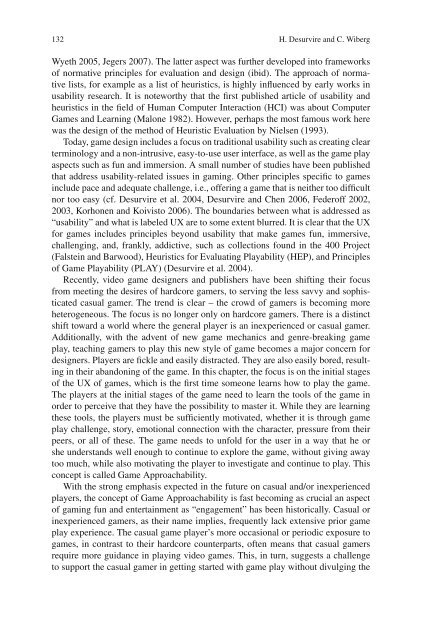Evaluating User Experience in Games: Concepts and Methods - Lirmm
Evaluating User Experience in Games: Concepts and Methods - Lirmm
Evaluating User Experience in Games: Concepts and Methods - Lirmm
You also want an ePaper? Increase the reach of your titles
YUMPU automatically turns print PDFs into web optimized ePapers that Google loves.
132 H. Desurvire <strong>and</strong> C. Wiberg<br />
Wyeth 2005, Jegers 2007). The latter aspect was further developed <strong>in</strong>to frameworks<br />
of normative pr<strong>in</strong>ciples for evaluation <strong>and</strong> design (ibid). The approach of normative<br />
lists, for example as a list of heuristics, is highly <strong>in</strong>fluenced by early works <strong>in</strong><br />
usability research. It is noteworthy that the first published article of usability <strong>and</strong><br />
heuristics <strong>in</strong> the field of Human Computer Interaction (HCI) was about Computer<br />
<strong>Games</strong> <strong>and</strong> Learn<strong>in</strong>g (Malone 1982). However, perhaps the most famous work here<br />
was the design of the method of Heuristic Evaluation by Nielsen (1993).<br />
Today, game design <strong>in</strong>cludes a focus on traditional usability such as creat<strong>in</strong>g clear<br />
term<strong>in</strong>ology <strong>and</strong> a non-<strong>in</strong>trusive, easy-to-use user <strong>in</strong>terface, as well as the game play<br />
aspects such as fun <strong>and</strong> immersion. A small number of studies have been published<br />
that address usability-related issues <strong>in</strong> gam<strong>in</strong>g. Other pr<strong>in</strong>ciples specific to games<br />
<strong>in</strong>clude pace <strong>and</strong> adequate challenge, i.e., offer<strong>in</strong>g a game that is neither too difficult<br />
nor too easy (cf. Desurvire et al. 2004, Desurvire <strong>and</strong> Chen 2006, Federoff 2002,<br />
2003, Korhonen <strong>and</strong> Koivisto 2006). The boundaries between what is addressed as<br />
“usability” <strong>and</strong> what is labeled UX are to some extent blurred. It is clear that the UX<br />
for games <strong>in</strong>cludes pr<strong>in</strong>ciples beyond usability that make games fun, immersive,<br />
challeng<strong>in</strong>g, <strong>and</strong>, frankly, addictive, such as collections found <strong>in</strong> the 400 Project<br />
(Falste<strong>in</strong> <strong>and</strong> Barwood), Heuristics for <strong>Evaluat<strong>in</strong>g</strong> Playability (HEP), <strong>and</strong> Pr<strong>in</strong>ciples<br />
of Game Playability (PLAY) (Desurvire et al. 2004).<br />
Recently, video game designers <strong>and</strong> publishers have been shift<strong>in</strong>g their focus<br />
from meet<strong>in</strong>g the desires of hardcore gamers, to serv<strong>in</strong>g the less savvy <strong>and</strong> sophisticated<br />
casual gamer. The trend is clear – the crowd of gamers is becom<strong>in</strong>g more<br />
heterogeneous. The focus is no longer only on hardcore gamers. There is a dist<strong>in</strong>ct<br />
shift toward a world where the general player is an <strong>in</strong>experienced or casual gamer.<br />
Additionally, with the advent of new game mechanics <strong>and</strong> genre-break<strong>in</strong>g game<br />
play, teach<strong>in</strong>g gamers to play this new style of game becomes a major concern for<br />
designers. Players are fickle <strong>and</strong> easily distracted. They are also easily bored, result<strong>in</strong>g<br />
<strong>in</strong> their ab<strong>and</strong>on<strong>in</strong>g of the game. In this chapter, the focus is on the <strong>in</strong>itial stages<br />
of the UX of games, which is the first time someone learns how to play the game.<br />
The players at the <strong>in</strong>itial stages of the game need to learn the tools of the game <strong>in</strong><br />
order to perceive that they have the possibility to master it. While they are learn<strong>in</strong>g<br />
these tools, the players must be sufficiently motivated, whether it is through game<br />
play challenge, story, emotional connection with the character, pressure from their<br />
peers, or all of these. The game needs to unfold for the user <strong>in</strong> a way that he or<br />
she underst<strong>and</strong>s well enough to cont<strong>in</strong>ue to explore the game, without giv<strong>in</strong>g away<br />
too much, while also motivat<strong>in</strong>g the player to <strong>in</strong>vestigate <strong>and</strong> cont<strong>in</strong>ue to play. This<br />
concept is called Game Approachability.<br />
With the strong emphasis expected <strong>in</strong> the future on casual <strong>and</strong>/or <strong>in</strong>experienced<br />
players, the concept of Game Approachability is fast becom<strong>in</strong>g as crucial an aspect<br />
of gam<strong>in</strong>g fun <strong>and</strong> enterta<strong>in</strong>ment as “engagement” has been historically. Casual or<br />
<strong>in</strong>experienced gamers, as their name implies, frequently lack extensive prior game<br />
play experience. The casual game player’s more occasional or periodic exposure to<br />
games, <strong>in</strong> contrast to their hardcore counterparts, often means that casual gamers<br />
require more guidance <strong>in</strong> play<strong>in</strong>g video games. This, <strong>in</strong> turn, suggests a challenge<br />
to support the casual gamer <strong>in</strong> gett<strong>in</strong>g started with game play without divulg<strong>in</strong>g the

















